 I can see the forest for the trees just fine. What I can't see is how you got us lost. 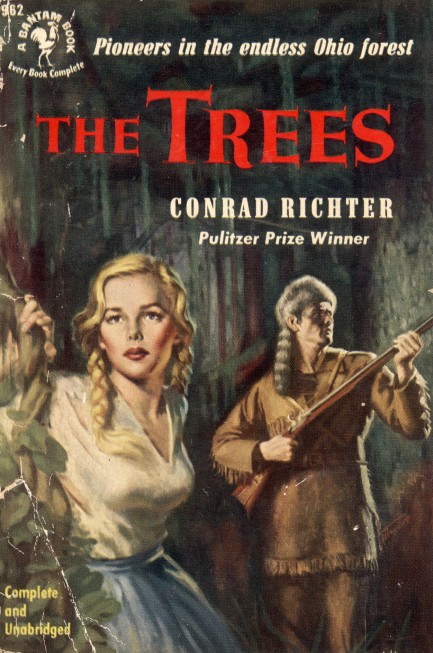
Above: Robert Maguire art for Conrad Richters's 1940 novel The Trees, which Bantam Books issued in this paperback edition in 1951. This was a serious novel, the first in an Ohio frontier trilogy known as The Awakening Land. The third novel, The Town, won Richter a Pulitzer Prize in 1951, which may have precipitated Bantam's pulpy re-issue. This isn't one we'll read, but we do like the art.
 If you don't get me out of here I'm a dead woman. The sheets are like sandpaper and the toilet has no seat. 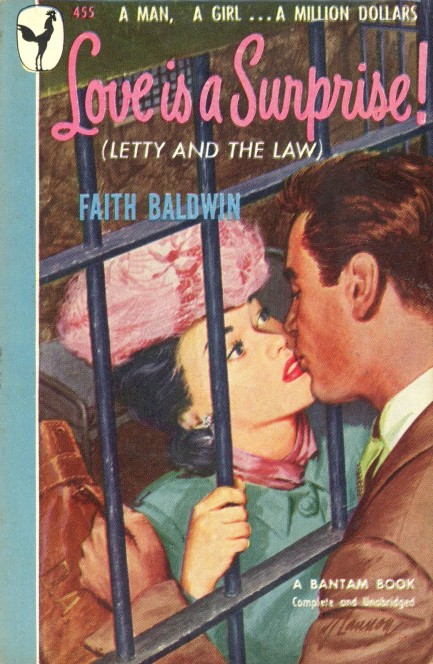
Above is a cover painted by Bert Lannon for the 1948 novel Love Is a Surprise! by Faith Baldwin, a major author of romance flavored fiction who produced around one hundred books in a career than ran six decades, from 1921 to 1977. Lannon is a new illustrator for us. We like his style. The moment he's used for his illustration is also highlighted by editors in the intro page:
She stood in the prison cell, a steel bar in either hand, her face pressed against the metal. He bent his head, and before she could pull away, just managed to kiss her startled lips. “My fee,” he remarked – and went toward the waiting sheriff.
We haven't read Baldwin, but we expect we'll run into something of hers we want to check out eventually. In addition, some of her work was translated to the silver screen, resulting in such films as 1937's Portia on Trial and 1938's Men Are Such Fools. Lannon, conversely, doesn't seem to have been very prolific. There's a little gallery of his work at Flickr, which you can see at this link.
 There aren't any bars, but there's no escape. 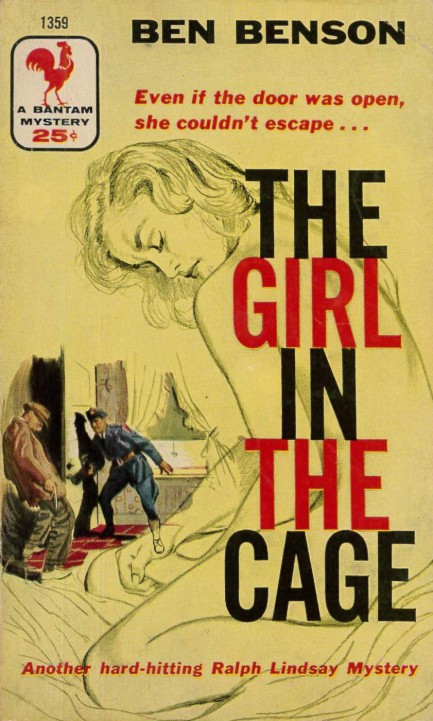
A few years ago we read a thriller by Ben Benson titled The Venus Death, the first of a series featuring his franchise character Massachusetts state trooper Ralph Lindsay. It was good enough that we wanted to return to Benson, so here we are with his second Lindsay novel, 1954's The Girl in a Cage. Benson writes in a style more akin to novels from the mid-sixties and beyond, which is to say things happen in his books. There's excellent pacing. The stories aren't built solely around dialogue. By a quarter of the way through this one there's a fistfight, a second fistfight/brawl, and a few other attention getting moments. Amidst all this trooper Lindsay is working undercover to bust a car theft ring, but finds himself dealing with an unusual brand of sociopathic kingpin. The caged girl of the title is Leta Nofke, who the villain considers his personal property, so much so that he's branded her. Lindsay thinks he can help her, but only if she wants to be helped. And there's the rub. Another nice effort from Benson, who we'll read again.
 Yeah, you're right, that was pretty evil of me. But I find that a swift kick in the nuts works better than plain old no. 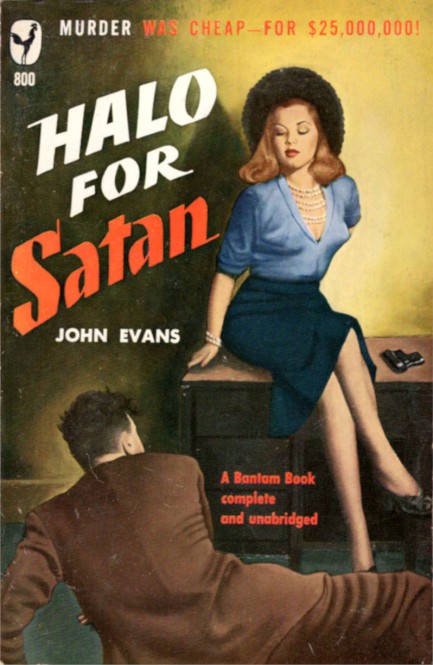
In detective yarns the MacGuffin—the thing everyone is chasing—might be a suitcase of money, or diamonds, or bearer bonds, or a shipment of heroin. In John Evans', aka Howard Browne's, intriguingly titled Halo for Satan the thing being pursued is an ancient parchment allegedly written by Jesus Christ. Its discoverer wants to sell it to the Catholic church for $25 million (that would a third of a billion in today's money), but disappears without a trace. A high ranking Chicago bishop hires private dick Paul Pine to find the missing man and document. Pretty soon others want the artifact too. One of them is a former top gangster who's near death and believes he can make his way into the good graces of the church—and thus into heaven—by donating the parchment. That's where the unusual title comes into play. A criminal Satan wants a halo.
Naturally, the question of authenticity is important to the story, but the central themes here are greed and ruthlessness. As Pine puts it: “You have to be a violent person to make money. I don’t necessarily mean the stab-and-shoot kind of violence. I mean the kind that will let you kick other people aside to get your hands dipped in gold.” Since the parchment is a classic MacGuffin, it doesn't appear until the end—like the Maltese Falcon. Meanwhile betrayals abound, bodies accumulate, and Evans turns numerous hard-boiled phrases while leading readers to a bloody resolution. We found Halo for Satan reasonably fun, even though it would be pretty thin without its gimmick. It was originally published in 1948, with this Bantam edition coming in 1950. The cover art is uncredited.
 If cats could talk they'd mostly threaten murder. 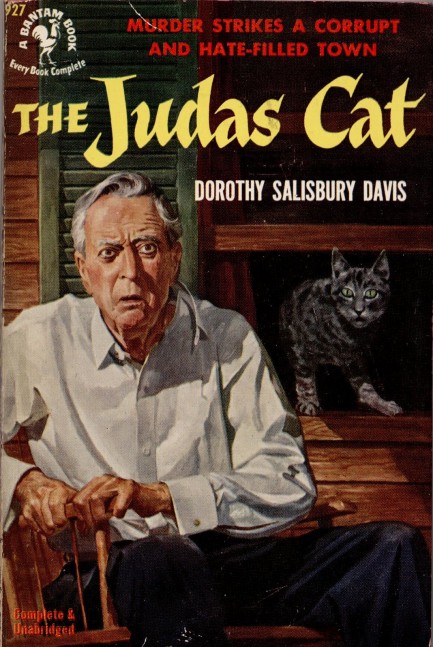
Above: a cover for the 1951 mystery The Judas Cat by Dorothy Salisbury Davis. We already discussed the book. Bantam occasionally released alternate covers for its paperbacks, so here's a second effort, with the uncredited artist going all-in on the creepy cat vibe.
 So here's the thing I prefer about indoor cats. You never have to do this. 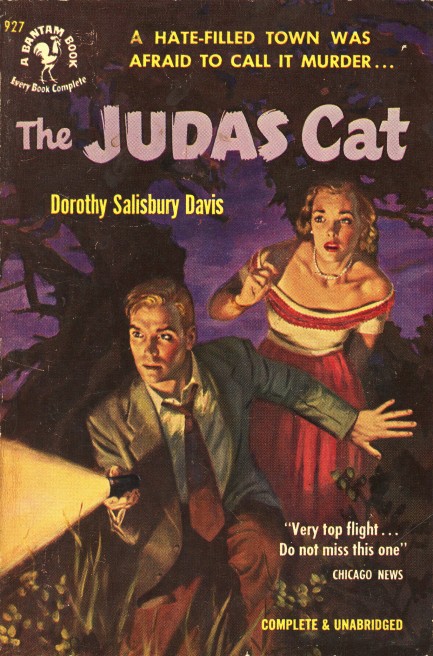
The Judas Cat by Dorothy Salisbury Davis is an unusual mystery about a ninety-two-year old toymaker and engineer found dead in a locked room with a terrified expression and scratches on his face. A few reviews of the book say the main suspect is the man's cat. Not really. Davis makes clear from the beginning that some malefactor may have used the cat in a mysterious way to facilitate the murder. The police chief Fred Waterman, who was so intimidated by the cat's aggressive behavior that he shot it just before discovering its owner's body, has it sent for a post-mortem to determine whether it was sick, had been posioned, or perhaps had poison on its claws. Local newsman Alex Whiting is the one who first notices something unusual about the animal's body. Thus begins the novel-length team-up between chief and reporter as they try to unlock the puzzle. While the method of murder continues to baffle them, the motives slowly coalesce around valuable patents, a will with a recent codicil, and hidden connections between various townspeople.
In general we liked the book. The characterizations are pretty sharp and the portrayal of life in a town where everyone knows everyone else's business is both fascinating and frustrating, as Davis intends. The story may not contain enough menace or action for some readers, but it's a pretty good example of a rural mystery, a decent examination of the effects of murder on a supposedly wholesome community, an interesting look at the quaint courtship rituals of the immediate post-war period (where a woman must simply wait to be noticed and courted), and a reminder of how political power was wielded in a time when those in control had fewer fears of exposure. We would read Davis again without hesitation, especially considering The Judas Cat was only her first novel. She probably got better with experience. We'll find out. We have another of her books. The nice purple cover on this 1951 edition from Bantam was not credited, and as we always say, that's a crime in itself.
 If you want to kill something, how about you knock off that pile of dirty dishes in the kitchen. 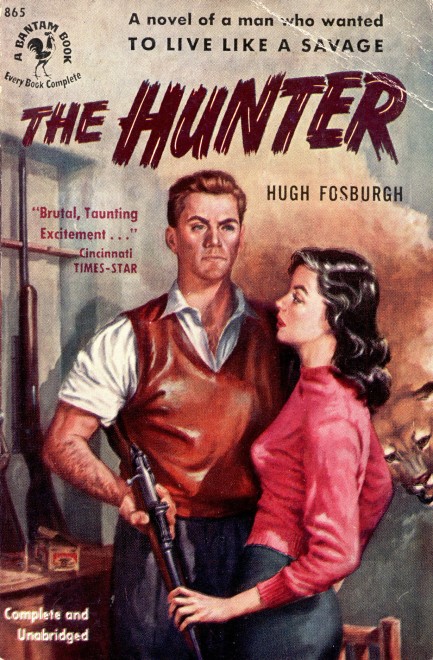
Above: a cover for The Hunter, by Hugh Forsburgh, for Bantam Books, 1951. This one is Hemingway with a geographical shift—big game hunter Monk Taylor lives and shoots in the Rocky Mountains instead of Africa. It's man, nature, and love, as Taylor is presented with the possibility having his macho fun ruined by a normal existence with faithful Marge Davies. We were tempted to buy it, but we already have other hunting novels on tap. The art on this is uncredited.
 1950 jazz mystery tries to take a step forward with an innovative approach. 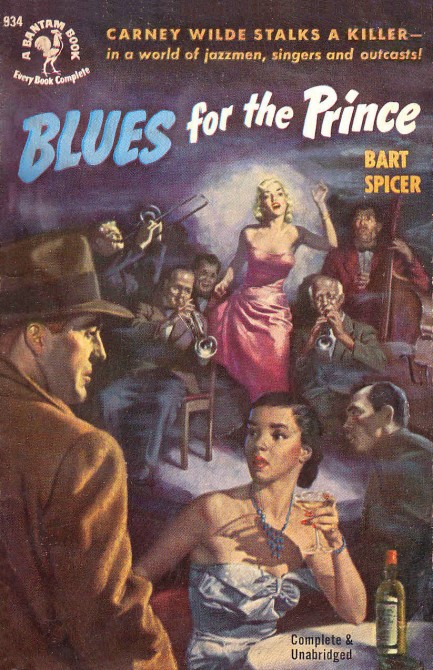
When you maintain a website that discusses vintage paperback art, you stop being amazed when a cover isn't credited. This one for Bart Spicer's 1950 novel Blues for the Prince is unattributed, and that's too bad, because the painter put together a nice scene. What's unique about the novel, as you might guess from the evocative art, is its setting within the black American jazz community (the blonde singer at centerstage does not materialize within the narrative, by the way). The plot revolves around a white detective named Carney Wilde hired to disprove claims that a murdered jazz legend's music was all plagiarized. Wilde at first ignores the homicide because it's unrelated to his assignment of determining the provenance of the songs, but he soon finds that the plagiarism claims and the killing are intertwined.
Fictional detectives are usually idealized creations. They're the toughest, smartest, and most irresistible of men, so why not the most egalitarian too? Wilde is basically color blind, even within his interior monologues—which is to say, he's not faking his lack of prejudice. It's an interesting choice by Spicer, as Wilde moves through an entirely black world, but proceeds without seeming to notice anything in the way of major ethnic or cultural differences. Obviously, this is because Spicer's narrative constructs no differences. He doesn't write of any notable poverty, impactful racism, or police brutalilty. Wilde does, however, see something of a difference in class. The dead musician—Harold Morton Prince, aka the Prince—has left behind a rich family that has plenty to protect. Wilde is firmly on their side, not least because the Prince is one of his idols. But in investigating the crime he learns that legends are humans too, and that scratching the surface of an idol often reveals something beneath the gleam.
The tale benefits from its unusual setting. It's solidly if unspectacularly written, we think, and improves as it progresses, ushered toward its climax by a nightclub scene in which Spicer shows off his musical knowledge by taking nearly an entire chapter to describe a hot jazz set. His approach to the story in general is a question worth exploration. If not for a few descriptions and one or two incidents of specifically aimed language, Blues for the Prince could be like many other mid-century novels set within the jazz world—i.e. these could all be white characters and you'd have essentially the same book. So Spicer really did two nearly opposite things here: he foregrounded black characters in a mid-century novel in a way most authors would not, and he suggested a potential evolution of black-populated fiction to a state of pure entertainment devoid of topical issues. If the novel were just a little better it would probably be widely discussed today. As it is, this jazz mystery is still worth a read.
 I plan to rise from soul crushing poverty into the soul crushing middle class, and if you play your cards right I'll take you with me. 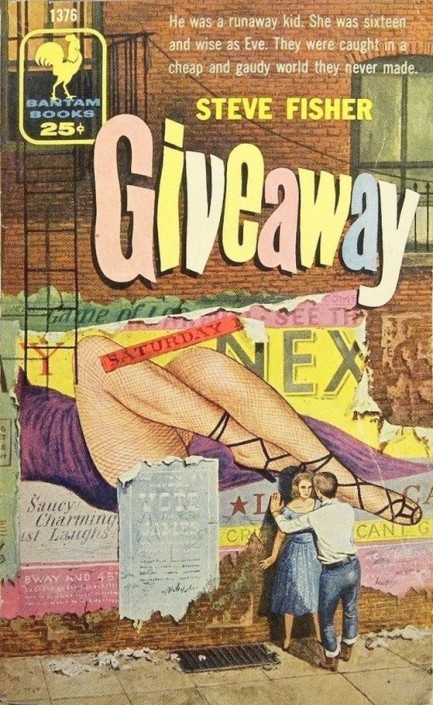
This 1955 Bantam edition of Steve Fisher's 1954 novel Giveaway has a front by James Hill that's at once beautiful and sordid. We've always been drawn to this art, so after seeing the book around for years we finally decided it was time to give it a read. Fisher tells the story of a seventeen-year-old Midwestern runaway named Eddie Shelton who ends up in Los Angeles and meets a mother and daughter who make their living by selling prizes they win for appearing on (fictional) game shows such as Down Melody Street and Cookies or Cash. It's difficult to get on the shows because the producers prefer novices, rather than “pros.” Jane, the daughter in this duo, sees Eddie as her ticket to being booked on a show called Man and Wife that offers huge prizes, including a trip to Hawaii and a year's wardrobe. She's willing to do anything for the chance—even convince Eddie she's in love with him.
The allegory is strong with this book. It reminded us of They Shoot Horses, Don't They?, with its capitalist critique folded within the characters' constant hope that a jackpot will lift them out of their meager circumstances, but it's also indebted to Catcher in the Rye because it features the same sort of youngish character who thinks the entire world is phony bullshit. Like that book, Giveaway is written in first person with copious slang and the feel of trying to make sense of a confusing society. We saw it labeled somewhere as juvenile fiction. It isn't. It stars two teens, but the themes from veteran pulp magazine contributor, crime novelist, and screenwriter Fisher are adult, and overall he crafts a good tale. His screenplays include Dead Reckoning, Lady in the Lake, and Johnny Angel, so a foray into the criminal underworld with him is mandatory. We have one of his crime novels, so that'll be an upcoming read, and we'll report back.
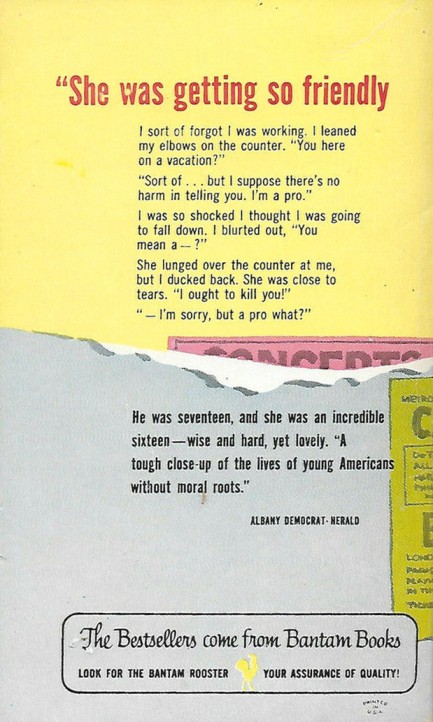
 There's no bottom in sight. 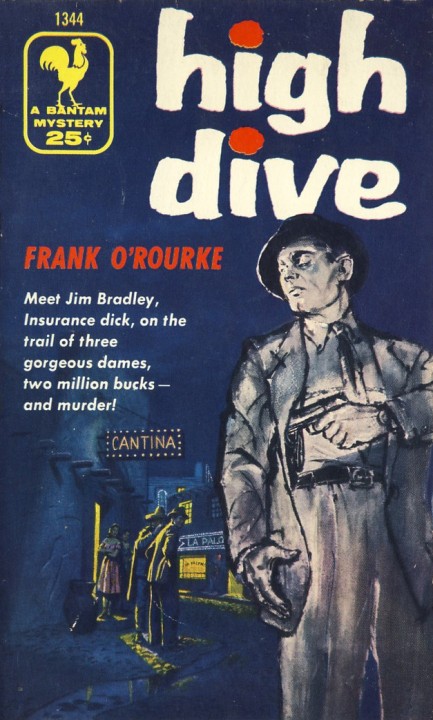
In High Dive Frank O'Rourke uses one of the time-honored tropes of mid-century crime fiction—the escape to Mexico. This 1955 Bantam edition has cover art which we like very much. It successfully captures the mysterious mood of the story, which centers around an unnamed Pacific resort town. That town is obviously Acapulco, a fact made clear from the book's cliff diving scenes. The fun begins when an insurance investigator named Jim Bradley rents a house in order to lie in wait for armored car robbers he feels will turn up there with the stolen loot sooner or later. He whiles away the months interacting with a menagerie of secretive expats, sultry women, and his true and faithful love Maria.
The most interesting aspect of High Dive is its style. It's lightly Hemingway flavored, making for a curious hybrid—part mystery, part lost generation. In addition to the prose, Hemingwayesque elements include: a sexually dissatisfied wife and a sad, cuckolded husband acting out their tragic pantomime of a marriage; numerous meet-ups for cocktails and generally constant drinking; an atmosphere of Americans existing but not thriving in a foreign land; and a local spectacle—not bullfighting, but cliff diving—that intermittently shifts from background to foreground in order to frame certain plot points. Yeah, it's pretty good, this book.
O'Rourke, who also published as Kevin Connor, Frank O'Malley, and Patrick O'Malley, mostly wrote westerns, and perhaps that's why he seems so comfortable in this Mexican space. For some readers it may take too long—about half the novel—for the protagonist to make actual headway solving the case of the armored car loot. His break finally comes when the wife of one of the robbers turns up in town. Or at least that's what he thinks. But is she really involved, and is her husband really one of the crooks? Perhaps, but by then the missing money isn't the attraction of the story. It's the disparate personal narratives, which are resolved as appropriate—triumph, tragedy, irony, and all the rest. High Dive was a pleasant surprise.

|
 |

The headlines that mattered yesteryear.
1945—Mussolini Is Arrested
Italian dictator Benito Mussolini, his mistress Clara Petacci, and fifteen supporters are arrested by Italian partisans in Dongo, Italy while attempting to escape the region in the wake of the collapse of Mussolini's fascist government. The next day, Mussolini and his mistress are both executed, along with most of the members of their group. Their bodies are then trucked to Milan where they are hung upside down on meathooks from the roof of a gas station, then spat upon and stoned until they are unrecognizable. 1933—The Gestapo Is Formed
The Geheime Staatspolizei, aka Gestapo, the official secret police force of Nazi Germany, is established. It begins under the administration of SS leader Heinrich Himmler in his position as Chief of German Police, but by 1939 is administered by the Reichssicherheitshauptamt, or Reich Main Security Office, and is a feared entity in every corner of Germany and beyond. 1937—Guernica Is Bombed
In Spain during the Spanish Civil War, the Basque town of Guernica is bombed by the German Luftwaffe, resulting in widespread destruction and casualties. The Basque government reports 1,654 people killed, while later research suggests far fewer deaths, but regardless, Guernica is viewed as an example of terror bombing and other countries learn that Nazi Germany is committed to that tactic. The bombing also becomes inspiration for Pablo Picasso, resulting in a protest painting that is not only his most famous work, but one the most important pieces of art ever produced. 1939—Batman Debuts
In Detective Comics #27, DC Comics publishes its second major superhero, Batman, who becomes one of the most popular comic book characters of all time, and then a popular camp television series starring Adam West, and lastly a multi-million dollar movie franchise starring Michael Keaton, then George Clooney, and finally Christian Bale. 1953—Crick and Watson Publish DNA Results
British scientists James D Watson and Francis Crick publish an article detailing their discovery of the existence and structure of deoxyribonucleic acid, or DNA, in Nature magazine. Their findings answer one of the oldest and most fundamental questions of biology, that of how living things reproduce themselves.
|

|
|

It's easy. We have an uploader that makes it a snap. Use it to submit your art, text, header, and subhead. Your post can be funny, serious, or anything in between, as long as it's vintage pulp. You'll get a byline and experience the fleeting pride of free authorship. We'll edit your post for typos, but the rest is up to you. Click here to give us your best shot.

|
|


























































































